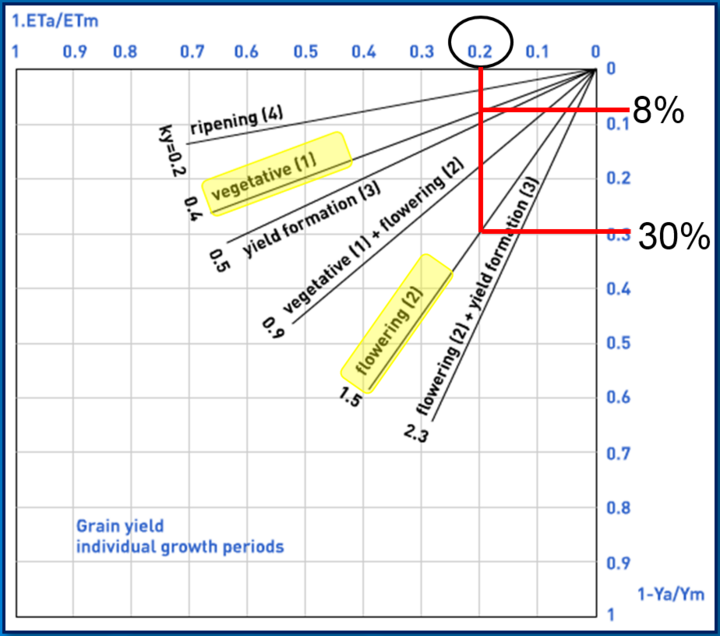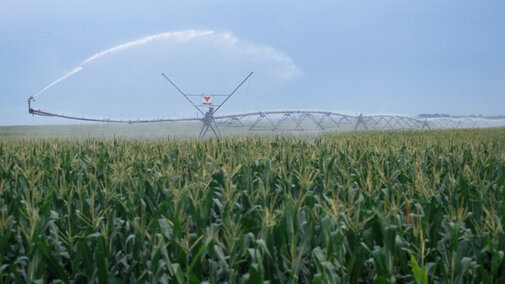So far June 2017, much like June 2016, has brought high temperatures and limited rains to much of Nebraska, causing some farmers to question whether they should start irrigating corn during the vegetative growth stage.
A few growers started up their center pivots this month to incorporate herbicides or soften a soil crust to aid emergence and early root growth. Others, with furrow-irrigated fields, may have made an early application, often before the crop actually needs much water, to wet the furrow and help ensure water will run the furrow length when full irrigation is needed.
Aside from these shorter term uses, how much irrigation is needed on corn in the vegetative growth stage?
Timing Irrigation for Maximum Impact
Growth Stage Irrigation Scheduling for corn should focus on delaying irrigation and reducing nitrate leaching during the less sensitive vegetative growth period and fully watering during the critical reproductive growth stages. This strategy, called Water Miser, is based on research conducted by the University of Nebraska and elsewhere that shows corn is relatively drought tolerant during the vegetative period, but very sensitive to water stress during silking through early grain fill. Research conducted in the North Platte area showed that irrigation could be reduced by 1 to 4 inches during the vegetative period without a significant yield reduction as compared to fully watered corn. Limiting irrigation during this time also may support crop roots growing deeper into moist soil.

The Water Miser strategy focuses on delaying irrigation until approximately one or two weeks before tassel emergence for corn, unless the soil-water drops to 30% of plant-available water in the active root zone. Once the crop reaches the reproductive growth stage, the plant-available soil water (in the active root zone) should be maintained in a range between field capacity and 60% of plant-available water. Usually the soil is maintained one-half to one inch below field capacity to allow for rain storage. After the hard dough stage, the soil is allowed to dry to 40% of plant-available water to reduce pumping and provide drier fields for harvest.
Figure 1, produced by the FAO (Food and Agriculture Organization of the United Nations), shows the relative relationship between yield decreases and evapotranspiration (ET) deficits for individual growth stages. The chart can be understood by knowing that the upper right hand corner represents a fully watered crop with full yield, thus no reduction of ET or yield; it is indicated by the zeros. The 0.5 on the top represents a 50% decrease in ET because of water stress and the 0.5 on the right represents a 50% reduction in yield. For example, a 20% ET deficit would result in an 8% yield decrease during the vegetative stage, whereas the same ET deficit would result in a 30% yield decrease during the flowering (silking) stage. The 8% yield decrease would be for a 20% reduction in ET from stress for each day from the time the corn emerges up through tassel.
Soil Moisture Sensors
Learn more about the value of soil water sensors and ETgages, as well as how to install them, in CropWatch. Find further information in the Agricultural Irrigation section of Water.unl.edu and the Nebraska Agricultural Water Management Network.
This week growers in some areas of Nebraska reported leaf rolling during the heat of the afternoon. Nebraska research suggests that some leaf rolling on a few afternoons during the vegetative stage will not reduce yield materially. Corn leaf rolling will often start in areas of soil compaction like field driveways or turn rows. These areas are usually small compared to the whole field, but are evident from the road. The bigger question is what is going on in the bulk of the field. Soil water monitoring is an excellent way to know how much water is in the root zone and give you confidence to delay irrigation.
In summary, research suggests that little irrigation is needed most years on corn during the vegetative stage to produce top yields in the eastern two-thirds of Nebraska on silt loam soils. Sandy soils will need more irrigation of course, but keep in mind the research shows moderate moisture stress during the vegetative stage will not usually lower yields much if any. However, fields with lower capacity irrigation systems—especially in combination with sandy soils—will need to start prior to the reproductive stage to assure corn can be fully watered by tassel time.

